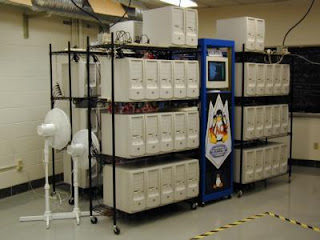Beowulf is a technology to group computers based on the system Linux operating to form a virtual supercomputer parallel. In 1994 under the sponsorship ESS project of the Center for Excellence in Science Data and Information Space (CESDIS), Thomas Sterling and Don Becker created the first Beowulf cluster for research purposes.
The following describes the hardware and software components that make up a
Beowulf cluster.
Beowulf has a multicomputer based architecture which can be used for parallel computing. This system consists of a master node and one or more nodes slaves connected via an Ethernet network or other network topology. It is built with common hardware components on the market, like any PC capable of running Linux, Ethernet adapters and switches standards. Since it contains elements special is completely reproducible. One of the main differences between Beowulf and a cluster of workstations (COWs cluster of workstations) is the fact that Beowulf behaves more like a single machine that many workstations. In most cases the slave nodes do not have monitors or keyboards and are accessed only via remote terminal or serial. The master node controls the whole cluster and serves files systems to slave nodes. It is also the cluster's console and the connection to the outside world. The Large Beowulf machines might have more than one master node and other nodes devoted to various specific tasks, such as consoles or workstations supervision. In most cases the slave nodes of a Beowulf are simple stations. Nodes are configured and controlled by the master node, and make only what prompted it. In a configuration of diskless slaves, these do not even know your IP address until the teacher tells them what it is.

Software

Beowulf operating system using any Linux distribution. It also uses message passing libraries such as PVM (Parallel Virtual Machine), MPI (Message Pasing Interface). In the beginning, Beowulf used the Slackware Linux distribution, Now most of the cluster distribution has migrated to Red Hat for its easy system administration. Without a doubt, the cluster presents an important alternative for many problems particular, not only its economy but also because they can be designed and adjusted for specific applications.
the alternatives for managing the resources of a Beowulf cluster is MOSIX. Mosix is a tool developed for UNIX-like systems whose characteristic stands out is the use of shared algorithms, which are designed to respond to instantly to changes in available resources, making the effective balancing
Mosix3 Using a cluster of PC's is that it works in such a way that the nodes function as parts of a single computer. The main objective of this tool is distribute the load generated by sequential or parallelized applications. A load balancing approach is performed by users when allocating different processes of a parallel to each node, having made a previous review manually the state of these nodes. Packages generally used for such work are PVM and MPI. This type of software, has tools for the initial allocation of processes to each node, regardless of existing load on the same or the availability of free memory each. these packages run at the user level as ordinary applications, ie they are unable to activate other resources or to distribute the workload in the cluster dynamically. the Most of the time the user is responsible for the management of resources in the nodes and manual execution of the distribution or migration programs.
Unlike these packages, Mosix performs automatic resource location available global migration and dynamic run "on line" 'of processes or programs to ensure the maximization of each node.













